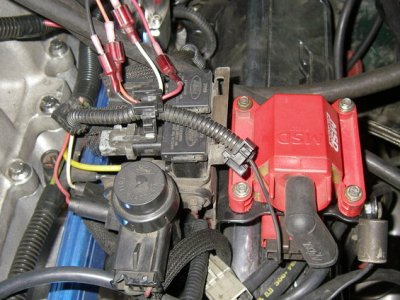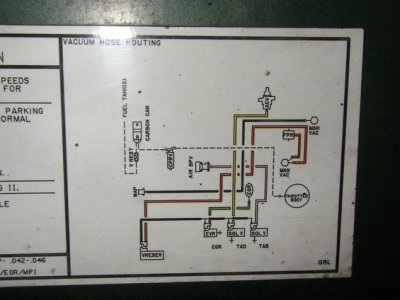YO,
I couldn't find my reply here at all; I searched for hours!
Tan is prob.:
Yellow = from the TAD Solenoid (driver's side Forward Solenoid) to the TAD (Diverter) Valve located at the rear of the Intake Manifold (Distributor Advance in Carbureted Engines);
& to summarize from this thread & one of our other discussions here;
Color Codes (EFI Engines):
Red = Main vacuum;
Green = EGR function;
Orange = Heat control Valve (exhaust & intake), AKA heat riser but more complex);
Yellow = from the TAD Solenoid (driver's side Forward Solenoid) to the TAD (Diverter) Valve located at the rear of the Intake Manifold (Distributor Advance in Carbureted Engines);
White = EGR vacuum (source);
Black = Thermactor ACV or Diverter valve;
Pink = from the TAB Solenoid (driver's side rear solenoid) to the bottom of the Thermactor Air Bypass Valve (TAB or BPV/AIR Bypass (AIRB) valve);
-----
Color Codes (EFI Engines, Late Model Years) By Ford via Steve83:
Black = Vacuum Reservoir Can (Tank) (VRESER) to TAD & TAB
Red = Main vacuum from Intake Manifold to Vacuum Reservoir Can (Tank) (VRESER)
Yellow = from TAD to Combined Bypass and Diverter Valve. located at the rear of the Intake Manifold
Pink = from TAB to Combined Bypass and Diverter Valve (see Seattle FSB info below)
==========
"...The Pink Vacuum Line goes from the TAB Solenoid (driver's side rear solenoid) to the passenger side (adjacent to the Vacuum Reservoir Can) and down to the bottom of the TAB (Bypass) Valve. Note that my Pink Vacuum line appears Yellowish in this pic and is not yet connected to the base of the TAB Valve as I was working up a solution at the time.,," by Seattle FSB (SeattleFSB)
--------
Color Codes by our PAL SEABRONC! (Some are in an 83 & probably Carbureted Engines):
Red = Main vacuum from Intake Manifold to Coffee can
Green = EGR function
Orange = Heat control Valve (exhaust & intake), AKA heat riser but more complex in Carbureted Engine Broncos/trucks
Yellow = Distributor advance
White = EGR vacuum (source)
Black = Mainly used for the Evaporative emissions control
Black = Thermactor ACV or diverter valve
Blue = Throttle Kicker control
Pink = Thermactor Air Bypass Valve (BPV)
======================
Vacuum Line Acronyms:
TAB is the Thermactor Air Bypass Solenoid
TAD is the Thermactor Air Diverter Solenoid
ACV (Air Control Valve) is the TAD (Thermactor Air Diverter) Valve (AIR Bypass (AIRB) and AIR Diverter (AIRD) valve combinations);
MAN VAC is Manifold Vacuum;
FPR is Fuel Pressure Regulator;
EGR is Exhaust Gas Re-circulation Valve
SOL V: Thermactor Air Diverter (TAD) Solenoid (SOL V) (AIRD) & Thermactor Air Bypass (TAB) Solenoid;
EVR is EGR Vacuum Regulator;
VRESER is the Vacuum Reservoir Can (Tank);
V REST on later years is Vapor Valve (Roll-Over);
V REST on earlier years such as SEABRONC's 83 is a Vacuum Restictor/delay valve, it delays vacuum for a certain amount of time;
Carbon Can is Carbon Canister (Charcoal Canister, Vapor Canister, Evaporative Emission (EVAP) Canister);
MAP is Manifold Absolute Pressure Sensor;
AIR BPV is the AIR Bypass (AIRB) Valve, also called the TAB (Thermactor Air Bypass) Valve;
CPRV is Canister Purge Solenoid Valve/ Canister Purge Solenoid (CANP);
VCKV is Vacuum Check Valve; CAT is catalytic converter;
ENG is engine;
PCV is Positive Crankcase Ventilation Valve
MAN VAC is Manifold Vacuum
CAT is the catalytic converter
ENG is the engine
---------
more by our PAL SEABRONC & Steve83 (includes Carbureted Models)
SV CBV = Carbureter Fuel Bowl Solenoid Vent Valve
LCV = EGR Load Control
WOT = Wide Open Throttle) Valve
HICV = Hot Idle Control Valve
IVV = Thermactor Idle Vacuum Valve
VRDV = Vacuum Delay Valve (VDV, VRDV, DV-TW)
VDV = Vacuum Delay Valve)
VRDV = Distributor ****** Delay Valve
DV-TW = Two Way Delay Valve)
HEAT VLV INT = Heat Vacuum Control Valve Intake, (next to carb)
======================
by AsianSpanker
CL: Located in the air cleaner
A/CL DV: Air Cleaner Diverter Valve
A/CL BI MET: Air Cleaner Bi-Metallic Valve
A/CL CWM: Air Cleaner Cold Weather Modulator
ACV: Air Control Valve
AIR: Ford calls this the Thermactor, short for Thermal Reactor. CA vehicles are installed with it as standard. Air Injection Reaction is what it stands for.
AIR BPV: Air Bypass Valve (aka Thermactor Air Bypass TAB)
BV: Bowl Vent (on top of the float tanks)
CARB: Carburetor
CPRV: Canister Purge Valve
DIST: Distributor
EGR: Exhaust Gas Recirculator
FLTR: Filter
FPR: Fuel Pressure Regulator
IVV: Thermactor Idle Vacuum Valve
MAN VAC: Indicating Manifold vacuum-Vacuum source
MAP: Manifold Absolute Pressure
SOLV: Solenoid Valve
SV-CBV: Carburetor Fuel Bowl Solenoid Vent Valve
VAC: Vacuum
VCKV: Vacuum Check Valve
VRESER: Vacuum Reservoir Solenoid Valve it is the vacuum resevoir
V CK V: Vacuum Check Valve
VRDV: Distributor ****** Delay Valve
TVS: Throttle Valve Solenoid (aka Solepot, Dashpot)
TVV: Thermostatic Vacuum Valve (aka Ported Vacuum Switches)
PURGE CV: Vapor Canister Purge Valve
--



